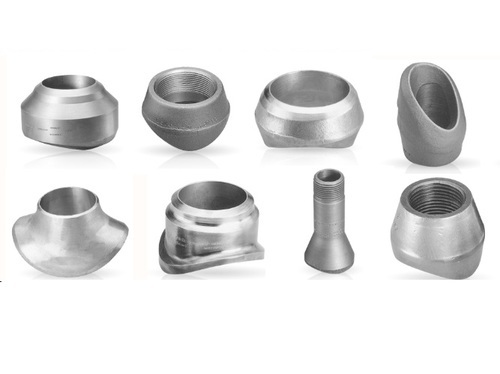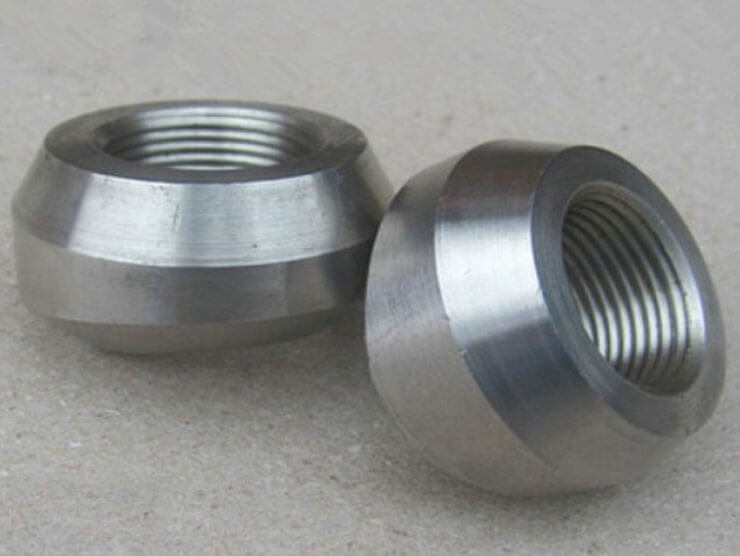

Our olet range includes:
OLETS
What are Olet Fittings
As an alternative to connections formed using buttweld tees, reinforcing pads, and saddles, pipe branch fittings are used to create integrally reinforced connections from a run pipe (header pipe) to an output pipe, at 45 or 90 degrees. These type of forged fittings are also known as "branch connections," "branch fittings," "pipe branch outlet fittings," and "Olets."
Olet fittings are forged products that have a higher level of strength and advantages than traditional pipe branching methods while also clearly being more affordable.
Reinforced branch connections are produced in a variety of sizes (to handle the majority of size-on-size or reducing connections), types/designs, connection types (buttweld, socket weld, threaded), and forged steel materials:
-carbon steel (ASTM A105 for high-temperature, A350 LF2/LF3 for low-temperature)
-alloy steel (ASTM A182 Grades F5, F9, F11, F22)
-stainless steel (ASTM A182 F304, F316, and other SS grades)
-nickel alloys (Inconel, Monel, Incoloy, etc).
Understanding the Different Types of Olet Fittings
Olet fittings come in various types, each serving a specific purpose in piping systems. The most common types include weldolets, sockolets, threadolets, and elbolets.
Weldolets are widely used for connecting branch pipes to the main pipe by welding. They provide a strong and reliable connection, making them suitable for high-pressure applications. Weldolets are available in different sizes and materials to accommodate various pipe sizes and types.
Sockolets are similar to weldolets but designed for socket welding instead of butt welding. They have a socket-shaped end that fits over the pipe, providing a quick and easy connection. Sockolets are commonly used for small-diameter pipes and low-pressure applications.
Threadolets are used when a threaded connection is required. They have a female threaded end that allows for easy installation and disassembly. Threadolets are suitable for low-pressure applications and can be used with both threaded and non-threaded pipes.
Elbolets are a combination of a weldolet and an elbow. They provide a 90-degree branch connection, eliminating the need for additional fittings. Elbolets are commonly used in tight spaces where a standard elbow fitting would be impractical.
When choosing the right type of Olet fitting for your project, consider factors such as the pipe size, pressure rating, and the type of connection required. Selecting the appropriate type will ensure a secure and efficient connection, minimizing the risk of leaks or failures. Remember to consult with industry experts or refer to relevant codes and standards to ensure compliance with safety regulations.
Factors to Consider When Choosing Olet Fittings
When selecting Olet fittings for your project, several factors should be taken into consideration to ensure optimal performance and safety.
Pressure Rating
One of the most critical factors to consider is the pressure rating of the Olet fitting. The pressure rating determines the maximum pressure the fitting can withstand without failure. It is essential to choose a fitting with a pressure rating that exceeds the intended operating pressure of your system. Failure to do so can result in leaks, pipe bursts, or other costly damages. Refer to industry standards and codes to determine the appropriate pressure rating for your specific application.
Size
Selecting the correct size of Olet fitting is crucial for a proper fit and functionality. The size of the fitting should match the size of the branch pipe and the main pipe. A mismatch in sizes can lead to poor sealing, reduced flow capacity, or even structural issues. Ensure that you accurately measure both the branch pipe and the main pipe, taking into account any wall thickness or insulation. Consulting industry guidelines or seeking expert advice can help you choose the right size for your project.
Connection Method
The connection method is another important consideration when choosing Olet fittings. The most common connection methods include welding, socket welding, and threaded connections. Each method has its advantages and limitations, depending on factors such as the pipe material, operating conditions, and ease of installation. Welding provides a strong and permanent connection, while socket welding allows for easy disassembly and reassembly. Threaded connections offer convenience but may not be suitable for high-pressure applications. Consider the specific requirements of your project to determine the most appropriate connection method.
Remember to also consider factors such as material compatibility, temperature range, and corrosion resistance when selecting Olet fittings. Choosing the right material and considering environmental factors will ensure the longevity and reliability of your piping system.
Olet Fitting Materials
Olet fittings are available in a wide range of materials, each offering specific advantages and suitability for different applications. Let's take a closer look at some commonly used materials:
Carbon Steel
Carbon steel Olet fittings are widely used in various industries due to their durability and strength. They are suitable for high-pressure and high-temperature applications.
Stainless Steel
Stainless steel Olet fittings are corrosion-resistant and offer excellent durability in harsh environments. They are commonly used in industries such as food and beverage, pharmaceuticals, and water treatment. Stainless steel fittings are available in different grades, each offering varying levels of corrosion resistance. Choose the appropriate grade based on the specific requirements of your project to ensure optimal performance and longevity.
Alloy Steel
Alloy steel Olet fittings are preferred for applications that require higher strength and enhanced resistance to corrosion and wear. Alloy steel fittings are available in various grades, each offering unique properties suitable for specific operating conditions.
Copper Nickel
Copper nickel Olet fittings are highly resistant to corrosion. Copper nickel fittings offer excellent mechanical properties, making them suitable for high-pressure and high-temperature applications. Copper nickel fittings are considered if the project involves marine or corrosive environments.
It is essential to choose Olet fittings made from the appropriate material based on factors such as corrosion resistance, temperature range, and compatibility with the transported fluid. Consider the specific requirements of your project and consult with industry experts to ensure the right material selection.
Applications of Olet
Olets have a wide range of applications in various industries :
-Oil and gas pipelines
-Power plants
-Chemical processing
-Petrochemical,
-Power generation
-Shipbuilding,
-Offshore platforms
How to Install and Maintain Olet Fittings
Proper installation and maintenance of Olet fittings are crucial for the longevity, performance, and safety of your piping system. Follow these guidelines to ensure correct installation and effective maintenance:
Installation
- Thoroughly clean the pipe ends and the Olet fitting before installation to remove any dirt, debris, or contaminants that could affect the connection.
- Ensure that the branch pipe and main pipe are aligned properly, and the Olet fitting is positioned correctly.
- Follow the recommended welding, socket welding, or threading procedures to ensure a secure and leak-free connection.
- Inspect the installed Olet fittings for any signs of damage, such as cracks or deformities, before putting the system into operation.
- Conduct pressure tests and visual inspections to verify the integrity of the installed Olet fittings and the overall piping system.
Maintenance
- Regularly inspect Olet fittings for signs of wear, corrosion, or damage. Any identified issues should be addressed promptly to prevent further deterioration.
- Clean Olet fittings regularly to remove any accumulated dirt or debris that could affect their performance.
- Monitor the operating conditions of the piping system to detect any abnormal pressures, temperatures, or flow rates that could impact the Olet fittings.
- Follow the manufacturer's recommendations for maintenance, including lubrication, tightening, or replacement of components if necessary.
Proper installation and maintenance of Olet fittings will ensure their optimal performance and longevity. Neglecting these steps can lead to premature failure, leaks, and costly repairs.
Stainless Steel Grades:
Duplex Steel Grades:
Inconel Grades:
| Inconel UNS N06600 Olets | Inconel UNS N06601 Olets | Inconel UNS N06625 Olets | Inconel UNS N08800 Olets | Inconel UNS N08810 Olets | Inconel UNS N08825 Olets |
